Energy Sector in Kenya
By Fredrick ouma
Kenya is among the five biggest economies in sub-Saharan Africa and is strongly integrated into the global economy through regional and international economic cooperation and conventions. The Kenyan economy is also one of the most diversified in East and Central Africa.
In line with its economic pillar in the long term development agenda under the vision 2030 initiative that aims to transform the country into an industrialized and middle income country that has a high quality of life, the government of Kenya has put in place the legislative framework that seeks to support investment opportunities and enhance local capacities in the infrastructure sector.
At the apex of the macroeconomic development, infrastructure networks that includes energy generation and distribution, roads, rail, ports, airstrips and airports are being propped up with the involvement of county governments.
 Energy and distribution is perhaps one of the key sector that is driving the country’s development agenda. The agricultural, manufacturing, communications, building and construction, food processing and packaging, education and health sectors are heavily dependent on reliable electricity. One of the key government priorities is Lamu Port Southern Sudan-Ethiopia corridor, a transport and infrastructural project in Kenya. Investment opportunities that exist in this project are in the construction of transmission lines for the power supply along the corridor.
Energy and distribution is perhaps one of the key sector that is driving the country’s development agenda. The agricultural, manufacturing, communications, building and construction, food processing and packaging, education and health sectors are heavily dependent on reliable electricity. One of the key government priorities is Lamu Port Southern Sudan-Ethiopia corridor, a transport and infrastructural project in Kenya. Investment opportunities that exist in this project are in the construction of transmission lines for the power supply along the corridor.
The national economic and social council (NESC) that advises the government on the management of the economy has been at the forefront of forging private sector participation in energy investment programmes by providing capital for energy projects.
The current installed electricity capacity in the country is about 2,333 MW. Electricity demand continues to rise due to increased economic activities. The government’s commitment to accelerate connections through the last mile connectivity initiative has seen an increase in capital outlay and distribution infrastructure in an effort to increase the installed capacity by 5,538 MW.
The objective of this connectivity programme is to increase the electricity access from the current 50% to 70% by 2017 and achieve universal access by 2020.
The energy sector has witnessed notable growth. The geothermal potential for Kenya is 10,000 MW. Currently 518.8 MW has been added to the grid but there is potential to develop more in Olkaria, Silali, Eburu, Menengai, Bogoria and other areas.
The government has also invested heavily in scientific research, drilling and generation of power from geothermal.
According to the energy ministry, the government is cognizant of the fact that joint efforts will be required from both the public and private sectors for accelerated development of the country’s geothermal resources and other renewable energy initiatives such as wind, hydropower, biomass and biogas.
The development in the energy sector has seen a steady supply of electricity. This is in contrast to a few years ago where high demand and unreliable weather conditions led to major power deficits as hydropower plants could not meet the demand.

